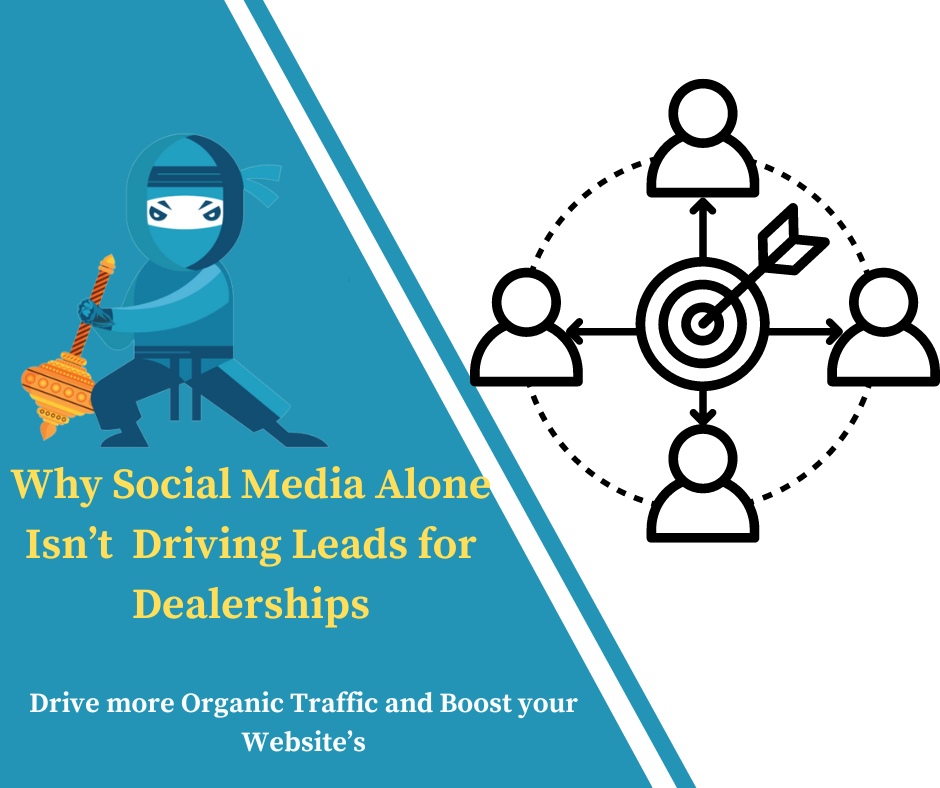Why Social Media Alone Isn’t Driving Leads for Dealerships
In today’s digital age, social media has become an indispensable tool for businesses across various industries. It provides auto dealerships a platform to engage with potential customers, showcase their inventory, and even build brand loyalty. However, while social media is a powerful tool, relying on it exclusively to generate leads may not yield the desired results. This is because it lacks the comprehensive approach needed to move potential buyers from awareness to conversion. Here’s why social media alone may not be enough for your dealership and what you can do to turn things around.
1. Limited Lead Capture Mechanisms
While social media is excellent for creating awareness and engaging with your audience, it lacks sophisticated lead-capture tools. Platforms like Facebook, Instagram, and Twitter are primarily designed for interaction, not conversion. Unlike a well-optimized website, social media doesn’t offer advanced lead generation forms, tracking, or analytics that are essential for moving visitors down the sales funnel.
For example, someone might “like” a post about a new vehicle model, but that engagement rarely translates into a serious lead. To capture leads effectively, dealerships need more than just social media engagement—they need tools like landing pages, optimized websites, and CRM systems that work alongside efforts to convert visitors into buyers.
2. Organic Reach is Declining
Once upon a time, businesses could reach a large percentage of their followers through organic posts on platforms like Facebook and Instagram. However, as these platforms have matured, their algorithms have evolved to prioritize paid content, making it harder for organic posts to gain visibility.
For dealerships that rely solely on social media without supplementing their efforts with other strategies, this decline in organic reach can severely limit their ability to generate leads. Paid advertisements and boosted posts may help, but they still require careful targeting, creative strategy, and supplementary lead-generation tactics to be effective.
Also read: 5 Mistakes Auto Dealers Make That Hurt Lead Generation
3. High Competition for Attention
Social media is flooded with content from every industry, making it increasingly difficult for any one brand to stand out. Dealerships are competing for attention against not only other dealerships but also countless other businesses, influencers, and individuals. Even if your content is engaging, it’s still only a small piece of the puzzle.
To effectively drive leads, dealerships need a multi-channel approach that integrates social media with other marketing strategies such as email campaigns, search engine optimization (SEO), and paid search ads. This helps to ensure that potential leads encounter your dealership at multiple touchpoints, increasing the likelihood of conversion.
4. Lack of Local Targeting
While social media platforms do offer geo-targeting options, they are not always as effective as local SEO or Google My Business (GMB) listings for capturing nearby potential customers. Many dealerships serve a specific geographic region, and relying on social media to attract leads from local customers can be hit-or-miss.
Local SEO and GMB listings, on the other hand, make your dealership more visible to people in your area who are actively searching for a new car. While should certainly be part of your local marketing strategy, it’s not a replacement for targeted, location-based tactics that can bring in more qualified leads.
5. Short-Term Engagement, Long-Term Conversion
One of the biggest challenges dealerships face with social media is that it’s designed for short-term engagement rather than long-term nurturing. A potential customer might see a post about a promotional deal and show some interest, but what happens after they’ve clicked away?
Without a strong follow-up system—like an automated email sequence or retargeting ads—most social media interactions are fleeting and fail to convert into sales. To effectively nurture leads, dealerships need to pair social media with tools like email marketing, remarketing ads, and CRM integrations that guide prospects through the buying process over time.
6. Misalignment with the Buyer’s Journey
The car-buying process is a complex one, with multiple stages from initial interest to final purchase. Social media is often most effective at the top of the funnel, where it can create awareness and generate curiosity. However, it’s less effective at the middle and bottom of the funnel, where potential buyers need more detailed information, reviews, and comparisons to make an informed decision.
For dealerships, relying solely on this can leave gaps in the buyer’s journey, preventing them from moving smoothly through the funnel. By integrating with other marketing channels—like a well-optimized website that provides detailed product information, a blog with comparison guides, and email campaigns with special offers—dealerships can ensure that their prospects are nurtured at every stage of the journey.
7. Incomplete Tracking and Analytics
Finally, while social media platforms offer some insights into post-performance, such as likes, shares, and comments, they don’t provide the full picture of how leads interact with your brand. The analytics provided by social media platforms are limited and don’t offer the level of detail required to track a lead’s journey from their first interaction to the final sale.
By relying alone, dealerships miss out on the deeper insights that can be gained from tools like Google Analytics, which can track a user’s entire journey on your website. Integrating these tools allows dealerships to make data-driven decisions that improve lead-generation efforts.
FAQ
Can social media alone generate leads for dealerships?
While social media can help create brand awareness and engage with potential customers, it is not enough on its own to generate consistent leads. A multi-channel approach that includes SEO, email marketing, and a strong website is essential.
What role does social media play in a dealership’s marketing strategy?
Social media is excellent for building awareness and engaging with your audience. It works best when integrated with other marketing strategies like email campaigns, local SEO, and paid search ads to nurture leads through the sales funnel.
Why is organic reach on social media declining?
Platforms like Facebook and Instagram prioritize paid content in their algorithms, which reduces the visibility of organic posts. This makes it harder for businesses to reach their audience without using paid advertisements.
How can dealerships improve their social media lead generation?
To improve lead generation, dealerships should use social media alongside other tools such as landing pages, email marketing, and CRM systems. This ensures that potential leads are captured and nurtured throughout the buying process.
Hire Figma Developer
What is the best alternative to social media for generating leads?
Local SEO, Google My Business listings, and a well-optimized website are excellent alternatives that work alongside to generate more qualified leads. These channels help attract local customers who are actively searching for dealerships.
Conclusion
While social media is invaluable for engaging with your audience, it should not be the sole pillar of your dealership’s lead generation strategy. To effectively convert social engagement into leads, you need a multi-channel approach that includes a strong website, local SEO, email marketing, and CRM systems. By combining social media efforts with other marketing channels, you can create a comprehensive strategy that captures, nurtures, and converts leads more effectively.








